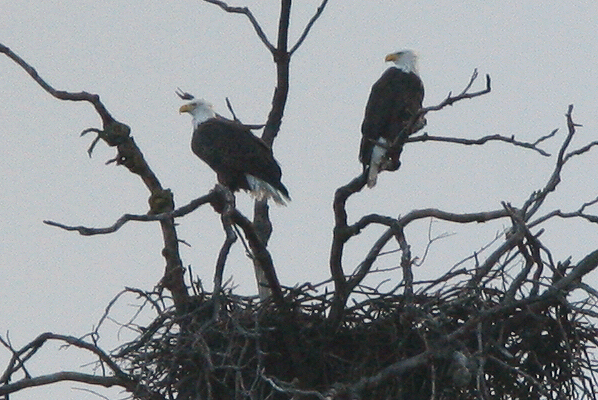
Date: 2006-02-05
Lens: Canon 300mm IS F4 + 1.4x II Converter

 Bald Eagle
Haliaeetus leucocephalus
Bald Eagle
Haliaeetus leucocephalus
 Description
Description
The Bald Eagle, which is our national symbol, was considered a bad choice by Benjamin Franklin because the bird sometimes steals food from other birds. He recommended the wild turkey. The Bald Eagle is an amazing bird that has survived near extinction by DDT (a type of pesticide), which causes egg shell thinning that prevents successful nesting. Today, Bald Eagle numbers are up through their protection under the Endangered Species Act and reintroduction programs using captive bred birds.
Some cool facts about this bird are:
1. It can reach speeds of up to 200 miles per hour while diving through the air.
2. The bird isn't actually bald. It has white feathers that stand out against it's overal dark plumage. Thus giving it the appearance of being bald.
3. Bald Eagles will sometimes hunt together, with one bird flushing prey towards the other.
General: 28 to 38 inches in length. Sexes similar, but female is slightly larger.
Adult: White head, upper neck, and tail. Dark brown body plumage. Large, yellow, thick, hooked bill. Pale eye. Yellow legs and feet.
Immature: Entirely dark brown plumage. Variable amounts of white on underwing coverts, belly, and back. Dark bill and cere. Yellow legs and feet. Adult plumage is gradually acquired over five years.
Breeds in forested areas near large bodies of water. Winters in coastal areas, along large rivers, and large unfrozen lakes.
 Nesting
Nesting1-3 eggs. The eggs have a 35 day incubation period. Fledging occurs in 70-98 days. The nest made from large sticks and lined with soft materials, such as pine needles and grasses. The nests are massive with diameters as large as six feet and weighing hundreds of pounds. The largest known nest was found in Florida and was 9 feet across, 20 feet deep, and weighed over two tons!